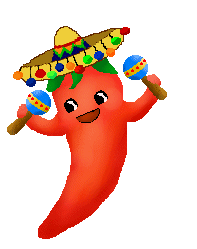 
Dia
de la Independencia |
What is el Dia de la Independencia?
Hispanic
Heritage Month begins on September 15 because this day marks the
anniversary of independence for five Hispanic countries—Costa Rica, El
Salvador, Guatemala, Honduras, and Nicaragua. In addition, Mexico achieved
independence on September 16, and Chile on September 18.
| Country |
Date |
Holiday |
| Argentina |
May 25 (1810) |
Revolution Day |
| Bolivia |
August 6 (1825) |
Independence Day |
| Chile |
September 18 (1810) |
Independence Day |
| Colombia |
July 20 (1810) |
Independence Day |
| Costa Rica |
September 15 (1821) |
Independence Day |
| Cuba |
January 1 (1959) |
Liberation Day |
| Dominican Republic |
February 27 (1844) |
Independence Day |
| Ecuador |
August 10 (1809) |
Independence Day |
| El Salvador |
September 15 (1821) |
Independence Day |
| Guatemala |
September 15 (1821) |
Independence Day |
| Honduras |
September 15 (1821) |
Independence Day |
| Mexico |
September 16 (1810) |
Independence Day |
| Nicaragua |
September 15 (1821) |
Independence Day |
| Panama |
November 3 (1903) |
Independence Day |
| Paraguay |
May 14-15 (1811) |
Independence Days |
| Peru |
July 28 (1821) |
Independence Day |
| Puerto Rico |
July 4 (1776) |
U.S. Independence Day* |
| Spain |
October 12 |
National Day |
| Uruguay |
August 25 (1828) |
Independence Day |
| Venezuela |
July 5 (1811) |
Independence Day |
|
Objectives:
Students will realize that countries
have celebrations unique to them.
* Students will demonstrate their
understanding of the concept of tradition.
* Students will identify a family
tradition that is important to each of them.
* Students will demonstrate their
understanding of the concept of independence
Time Required:
4 to 5 days
Vocabulary:
Independence, traditions
Materials:
*map of Hispanic Countries
* construction paper for flags and decorations
* ingredients for recipes and cooking supplies
* member of the community to teach a dance
Procedures:
- Tell the students a story of a tradition that you
have been a part of during your life. Give lots of details so that they can
picture what it was like. Ask students to identify a few traditions that
they are familiar with. Write the ideas on the board.
- Explain that different countries have holidays
with which we may be unfamiliar. In Hispanic countries, holidays are called
festivals or fiestas. Tell what a fiesta is and some ways they are
celebrated. Show the students where the Hispanic countries are on the map.
Briefly describe the countries. An example of a fiesta in Hispanic countries
is Independence Day. Explain to the students that just as the United
States has reasons from history as to why we celebrate our independence, so
do other countries. Put the name of the holiday and the corresponding date
on the board. (Refer to table above)
- Have each child think of reasons why a country
would want to have independence or freedom from another country. (e.g.,
religious freedom, different governing, values). Have the students pair up
and share their ideas with their teammate. Invite some students to share
more broadly with the whole class.
- Explain to the students the history of each
Hispanic countries revolt. Tell the events that led up to the war and how
the war was started. Explain who where the important figures.
- Review information regarding fiestas. Explain the
events that take place in the Hispanic countries on the Eve of Independence
Day and on Independence Day. Define the concept of tradition (an event
or thing that is carried out or acted upon each year at the same time). Ask
the students what they do every year the same way. Give examples of
traditions, Christmas activities, Thanksgiving, Easter, Birthdays,
Anniversaries. Share a story of a personal tradition. Have the students
write a story of a tradition that they have. Choose several students to
share their story with the class.
- The colors of the different country's flag each
symbolize something to the people. For example the Mexican flag: The
green symbolizes independence, white symbolizes religion, and red symbolizes
union. Talk about how things are decorated in these colors for the fiesta,
for example: flags, flowers, lights, confetti, noise makers. Have the
students make one of these items as if it were for a decoration for a town
square on Independence Day. Display the items made as decorations in the
classroom. Remind the students what each color symbolizes.
- Have a Independence Day celebration in the
classroom. Have the students make typical foods. They can wear the colors of
the country's flag. Have a member of the community come into the classroom
and teach the students something about their culture.
- Students choose a country they would like to
research. After compiling information, the students will create a
slideshow depicting 5 important facts about that country's Independence Day.
Evaluation:
Country Study Slideshow presentation Rubric
Extension Activities:
What is the difference between el Dia
de la Independencia and el Cinco de Mayo? Read this article and tell why "El
Grito" (The Cry)
Home Learning:
Using a venn diagram compare and
contrast two different countries celebration of Independence Day.

Home |